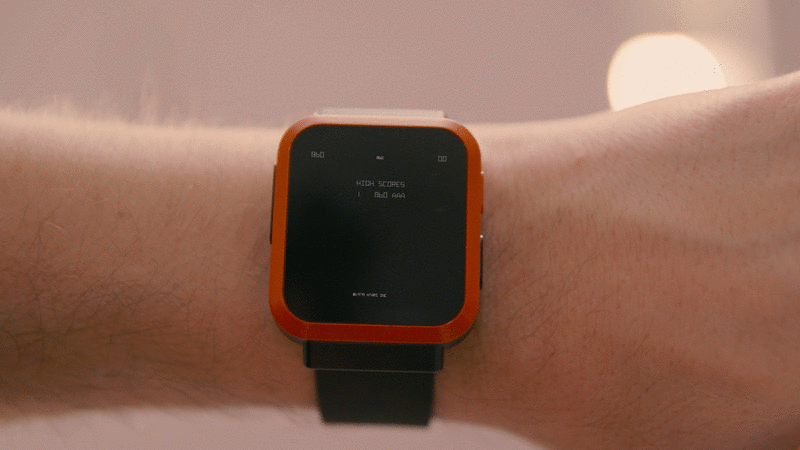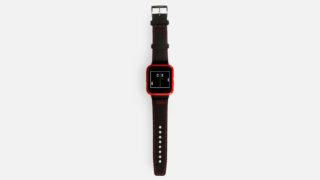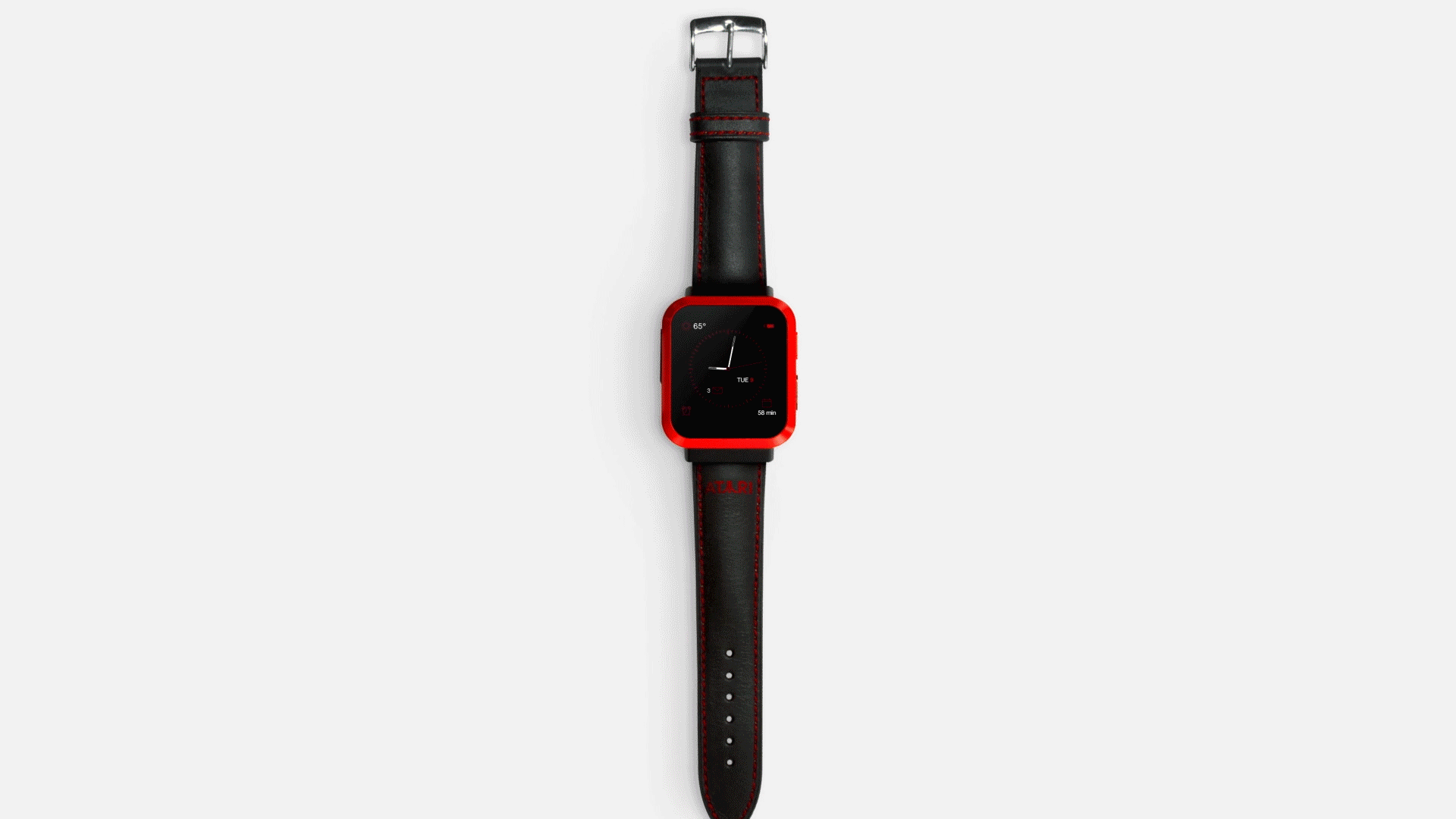Although smart watches haven’t exactly taken off, particularly among gamers, FMTwo Game believes that it can buck that trend with a new device called Gameband, which began its Kickstarter campaign today. Developed by Matter Global (a studio with a portfolio that includes Samsung, Google, Sonos, and Logitech), the crowdfunded device promises to be the most powerful smart watch on the market, but will be more affordable than anything currently available. That’s because the company is focusing specifically on features that will appeal to gamers and forgoing things like heart rate and step monitors.
Additionally, FMTwo has partnered with Re-Logic, makers of the hit indie game, Terraria, and Atari to offer to special edition Gamebands to fans. Gamebands will also come pre-loaded with 20 mini-games that include classics such as Pong, Centipede, and Asteroids. The Gameband will expand its library of games following its launch, which will be complemented by a collection of interchangeable watch bands and digital watch faces.
Feargal Mac Conuladh, CEO and founder of FMTwo Game, said that: “What’s joyful about doing something on Kickstarter is building something that you yourself would get.” He talks to [a]listdaily about how gamers will get to have the most powerful smart watch in the world at an affordable price.
 What is Gameband, and what inspired it?
What is Gameband, and what inspired it?
We looked at smart watches in the world today, and they kind of all look the same and do the same things. I think the market hasn’t quite taken off yet because most of what’s out there is too generic. We also looked at different groups, and one that we know well is gamers. So, we said, “what if we make a smart watch for gamers, taking into account what they want, and make it outstanding with the stuff that’s important to them?”
So, rather than putting in heart rate and step monitors, we focus on what’s really important. What led to the Gameband was the belief that we could create a powerful smart watch for gamers and build functionality that speaks to them. Previously, we had worked on a product for Minecraft, which was a band with a drive on it that let you play the game anywhere, and we learned a lot from that experience. We learned that despite cloud technology, people like having their games close and being able to plug into any computer to continue playing. We wanted to bring that functionality to a smart watch.
How does the Gameband compare to existing smart watches made by Apple, Samsung and Razer?
They’re all great companies, but we think we stack up pretty well. When you look at gamers, they’re pretty demanding. They want the best computer, screen and headphones, so why should this be any different? One of the things we wanted from the beginning was to make sure the processor, display and connectivity that we built into this would be the best, and that led to our partnership with Qualcomm.
We also went for a square AMOLDED display. There are a lot of round devices on the market, and that’s because they’re watches that do more. We not looking at this as a watch that does more; we’re looking at it as another window—another screen—into your gaming life. So, it stacks up really well against the competition in terms of specs and size.
The area where we’ve added something extra is an upgradable micro SD card slot. A lot of devices will just give you notifications. We built in this gaming drive that runs our software, PixelFurnace, which is launch, backup and storage software. You could put a game (such as Terraria) on this, and plug the Gameband into any computer wherever you go to play it directly from the drive. Or you could put photos, music and other stuff on it and access them through Bluetooth. This drive, which can go up to hundreds of gigabytes, adds a layer of functionality—it’s not just buzzing notifications from your phone. It’s doing a lot more.
Apple and Samsung also have massive mobile phone businesses, which are highly profitable. As a result, I think a lot of these brands aren’t thinking about how to build the best smart watch in the world. They’re expanding product lines. We don’t have a phone business, so the only thing we think about is how to build the best smart watch that there is.
Is the Gameband more of a wearable console or a gaming companion device?
In some ways, it can do both. You can put a full PC game on the micro SD and play from it. But the games that will actually run on the watch itself—you need to be careful with that to make sure you do it right. We have mini-games that will play well on that smaller screen and companion apps are things that we’re looking very closely at. We want bigger games to have an opportunity to have an app on Gameband, and we’re talking to a number of big studios about it.
But the mini-games that we’re launching with are also very interesting. What a lot of people have done so far is try to shrink games down to a smaller screen, and that doesn’t work. So, we’re re-writing the retro games that we’re going to launch with from scratch. We’re taking into account the screen size and gestures that work the best: sliding, tapping, moving your arm and pushing buttons. We’ve got some really smart folks working on remaking the gaming experience to make them enjoyable. I wouldn’t call it a console, but I think we’re doing something interesting that people are really going to like.

People might imagine that it’s very awkward to play Terraria or Centipede on a tiny watch screen. How are you going to overcome this perception?
Re-Logic is a great company to work with, and they brought Terraria to multiple platforms. One of the reasons we have such a great relationship with them is because they quickly got how big this could be. But they also understood that this is a different tech and different context. I think a lot of people are waking up to that. If you look at Pokémon Go, you’ll find that there are a lot of different ways to game, and the physical and digital world are going to collide in ways they never have before.
There’s a lot of interesting stuff one can do so that it’s not just poking away at a small screen. It’s about what you’re doing in the world—the way you move your arm, and different gestures. The technology lets us bring in a lot of different stuff to how the games are going to play. We’re forming these relationships [with companies], doing a joint special edition approach like with Terraria and Atari, and we get a much closer relationship with them. They start bringing in their creativity on how to adapt their games to this technology. But ultimately, early adopters who talk about the Gameband will break the perception.
 How did you come to partner with Atari?
How did you come to partner with Atari?
One trend we noticed about the gaming scene is that retro games are hugely popular. One of the things that attracted me to Atari was that you have huge audience that remembers it from the old days and has an affinity for that brand. It’s more than just gaming and it’s kind of like Apple. The brand transcends the product of the time. But the thing that blew me away about Atari was that younger players in their early teens know these games as well. That really opened my eyes. The level of education and knowledge that younger gamers have today about retro brands blew me away.
We went to Atari because they have affinity from all age groups, and we believe those games are going to play well on this format.
Given how mobile gaming is growing at such a significant pace, what audience are you trying to reach with the Gameband?
It’s pretty broad. One of the things about smart watches today is that they’re designed for an older demographic. People have said to me that teens and millennials don’t wear watches anymore. Well, we haven’t offered them anything that makes sense for them from a price, content and design standpoint. I also think that the younger demographic like to game, connect and message, but they don’t necessarily need the heart rate monitor or all this other stuff that people want to cram in. That’s why we went with two or three top-of-the-line components that let us come in with a price that’s more affordable than some of the other things on the market.
The target market we’re going after is gamers—a bit younger than what Apple or Samsung are going after.
How are you getting the word out about the Kickstarter campaign?
We already have a large base of people we’ve been reaching out to over email who are keen to get more information. We’re also active on social media, and partners such as Atari and Terraria (Re-Logic) are helping. The have a lot of fans and followers, and they’ve been putting out the message that something new is coming. Then, on Kickstarter, we’re offering the best deals we can. It’s really about getting to that fan base and driving through social media.


